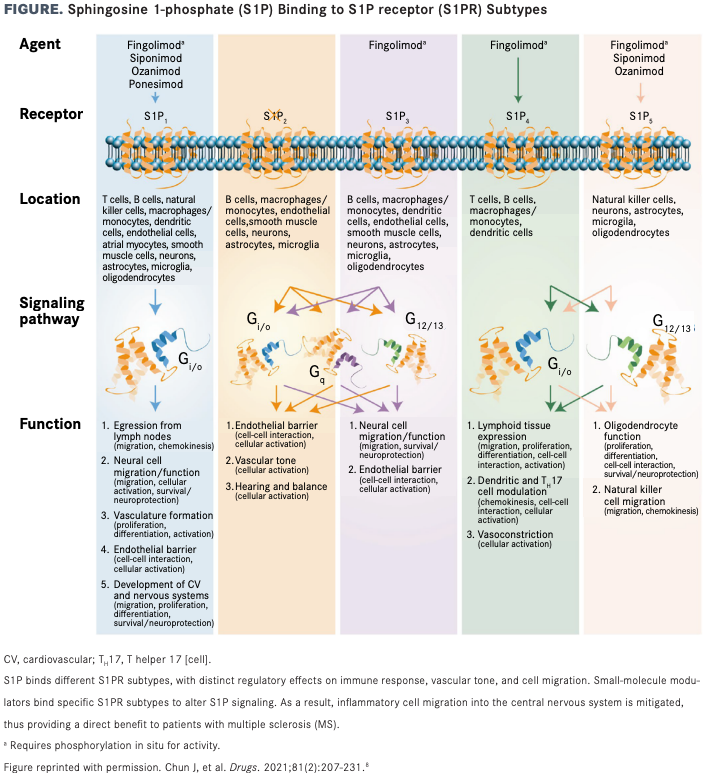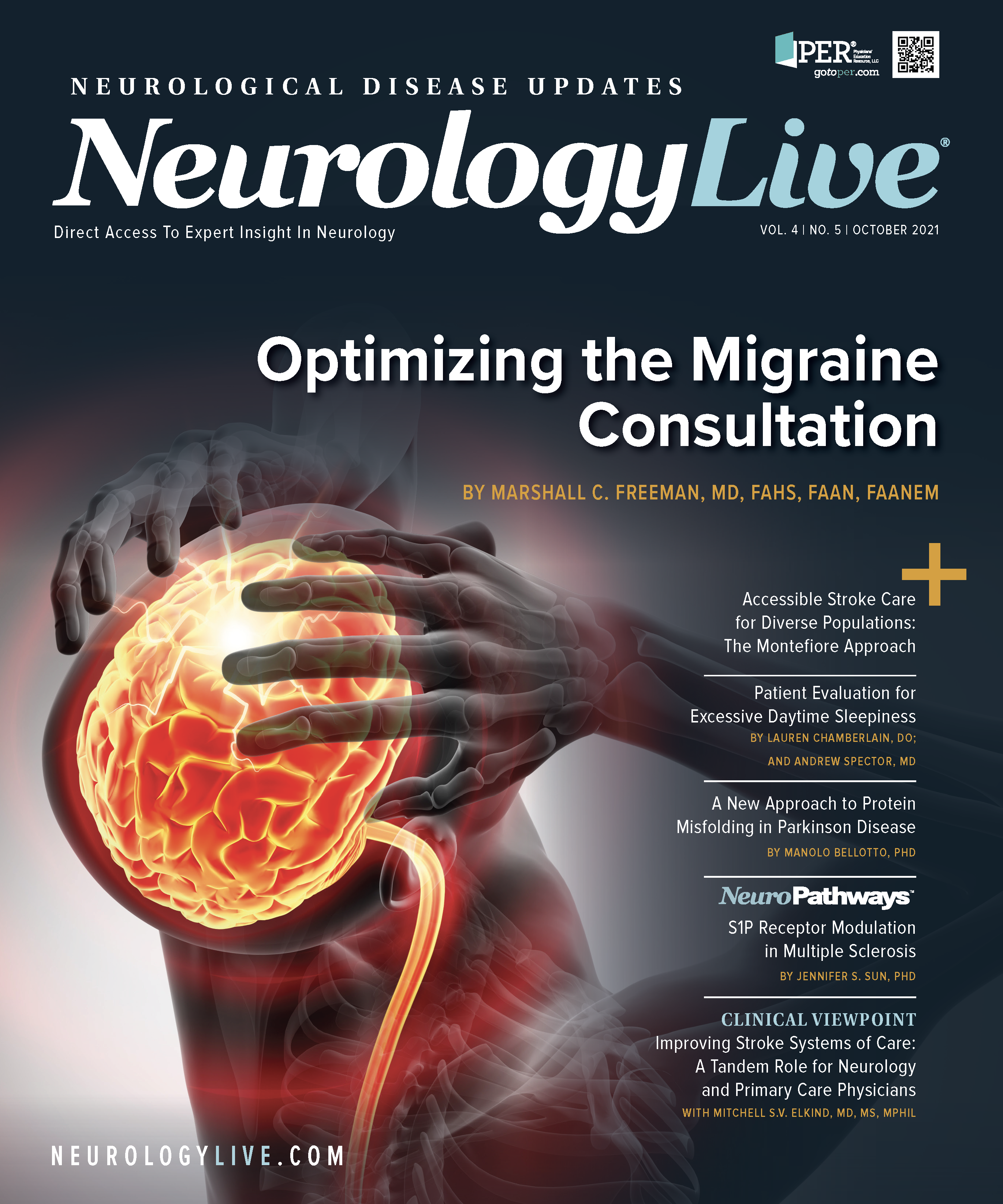Publication
Article
NeurologyLive
S1P Receptor Modulation in Multiple Sclerosis
Author(s):
Continued improvement in the pharmacodynamics and pharmacokinetics of S1PR modulators, particularly in modulator-receptor selectivity, should improve therapeutic efficacy while reducing the potential for AEs.

MULTIPLE SCLEROSIS (MS) IS THE MOST COMMON autoimmune mediated disorder of the central nervous system (CNS), affecting approximately 2.3 million people worldwide with nontraumatic disabling neurological impairment.1-4 Although the precise cause of MS remains unclear, most patients are believed to have inherited a genetic predisposition for the disorder.1,2 The neurological symptoms of MS are thought to be triggered by an autoimmune response in the white matter of the brain and spinal cord that causes axonal demyelination, degeneration, and incomplete paralysis.1,2,4,5 Briefly, the body’s immune system attacks myelin, the protective sheath surrounding nerve fibers, to potentially permanently short-circuit the nervous system.2-6
Jennifer S. Sun, PhD

Presently, MS has no known cure.1,2 Drugs have been developed to manage the major symptoms of MS, although not completely satisfactorily: some therapies are not well tolerated, others are initially effective but become less so as the disease progresses, and yet other maladies are difficult to treat until the underlying cause is elucidated.2,3,7 Now, a focus on disease-modifying therapy seeks to do more than just manage symptoms, instead attempting to alter either the frequency of relapses or the rate of progression.2,3 Yet, drug development for MS is particularly challenging because the known causal gene targets are regulatory molecules in multiple biological pathways, so there is a heightened risk of off-target physiological effects.5,6,8
The clinical course of MS is highly heterogeneous but can be broadly classified into relapsing and progressive forms.2,3 In relapsing-remitting MS (RRMS), episodes of neurological disability are separated by periods of clinical stability.2,6 RRMS eventually transitions into secondary progressive MS (SPMS) as disability progressively worsens.2,6 Early treatment of patients with RRMS can potentially prevent, reduce, or delay progression to SPMS2. However, the axonal loss and demyelination resulting from chronic inflammation in SPMS may be irreversible.7,8
Sphingosine 1-phosphate (S1P) is a bioactive lysophospholipid signaling molecule that is critically involved in a wide range of physiological and pathophysiological events (FIGURE).8 Erythrocytes and endothelial cells are the major sources of S1P in the plasma,5,8 whereas mast cells and platelets contribute to elevated local production of S1P under inflammatory conditions.5 Phosphorylation of sphingosine by kinases produces this potent signaling molecule, which acts as an extracellular first messenger and intracellular second messenger.5 S1P functions as a ligand for a group of cell surface heterotrimeric G protein–coupled receptors called S1P receptors (S1PRs), which propagate the ligand-binding signal.5,8 In so doing, S1P regulates hormone synthesis and activation,9 embryonic development of the cardiovascular system and the central nervous system (CNS), vascular permeability, vascular smooth muscle tone, and immune cell trafficking.5 Elevated S1P levels in cerebrospinal fluid and brain parenchyma of patients have been associated with MS progression.8,10
FIGURE. Sphingosine 1-phosphate (S1P) Binding to S1P receptor (S1PR) Subtypes (Click to enlarge)

Five S1PR subtypes exist, S1PR1 to 5, which vary in terms of expression pattern and functional role. S1PR modulators display varied effects depending on the subset of S1PR subtypes they target.6,8 S1PR1 is expressed in the endothelium, where it recruits dendritic cells and controls vascular permeability and heart rate, and it is also found on lymphocytes, where it mediates migration from lymph nodes. S1PR2 is expressed in the CNS and plays essential roles in the mediation of neuronal excitability, but it has no known role in immune function. S1PR3 is found on cardiac myocytes and endothelial and vascular smooth muscle cells, where it regulates myeloid differentiation, although most of its activities parallel those of S1PR1.8,11 S1PR4 is expressed on immune cells in lymphoid tissues, where it functions in regulating cytokine expression. Finally, S1PR5 is expressed on oligodendrocytes in the CNS; it regulates the function and migration of these cells.5,6,8 There is some redundancy among the signaling pathways associated with different S1PR subtypes.8 Moreover, S1PR1, S1PR3, and S1PR5 subtypes share structural similarity.8 For these reasons, the design of highly specific therapeutics targeting each S1PR subtype is difficult.6,8 Most S1PR modulators in clinical development or approved for MS treatment primarily target S1PR1, with concurrent effects on 1 or more other S1PR subtypes, particularly S1PR5.5,6,8
S1PR modulation therapies have been approved for MS.5 Smallmolecule therapeutics bind to and alter signaling through specific S1PR subtypes.5,6 The goal of this therapeutic approach is to inhibit immune cell trafficking and improve neuroprotection.5,6 Indeed, S1PR modulators have been demonstrated to enhance neuronal survival and mitigate gliosis and demyelination in a mouse model of MS.6 A separate study in patients with nonrelapsing forms of SPMS captured a direct benefit of S1PR modulators—reduction of neuronal damage when compared with placebo.8 The most prominent therapeutic target is S1PR1.5,6,8 Small-molecule modulators functionally antagonize S1PR1 signaling by binding to this receptor on lymphocytes, which then causes receptor internalization and prevents lymphocyte egress from lymph nodes.8 The resulting sequestration of autoreactive lymphocytes limits inflammatory cell infiltration into the CNS.5,6,8
One caveat of this is approach is that these agents often affect S1P signaling in a variety of nontarget tissues due to the diverse expression pattern of S1PR1 and thus can trigger adverse effects (AEs).5,6 For example, S1PR modulators can cause slowed heart rate upon initiation of therapy due to S1PR1 expression on atrial myocytes.6 S1PR modulators can also cause progressive multifocal leukoencephalopathy due to John Cunningham virus reactivation, as well as macular edema and increased blood pressure.5 Second-generation agents can potentially improve the convenience, safety, and tolerability of MS therapeutics.5
Fingolimod (FTY720; Gilenya) is the first-in-class S1PR modulator for treatment of RRMS.5 A structural analogue of endogenous sphingosine, fingolimod is a lipophilic molecule that can readily cross the blood-brain barrier, where it is phosphorylated by sphingosine kinases into its active form, fingolimod-P.5,8 Fingolimod exhibits high oral bioavailability (93%), with a time to maximum plasma concentration (Tmax) of 12 to 16 hours, and reaches steady state after 1 to 2 months of regular dosing.5 However, active fingolimod-P is found at relatively low concentrations.5 Recovery of mean lymphocyte count after treatment discontinuation can take 4 to 8 weeks.5 Severe rebound effects can occur up to 12 weeks after discontinuation, perhaps due to changes in peripheral lymphocyte phenotypes that promote disease activity.5 A series of large, multicenter, randomized, double-blind phase 3 clinical trials examined the safety and efficacy of fingolimod for: the treatment of PPMS (INFORMS [NCT00731692]12) or RRMS (FREEDOMS [NCT00289978],13 FREEDOMS II [NCT00355134],14 TRANSFORMS [NCT00340834]15), including for RRMS in pediatric populations (PARADIGMS [NCT01892722]16). FREEDOMS and FREEDOMS II revealed a significant reduction in annualized relapse rate (ARR) of RRMS at 24 months and improvements in inflammatory disease activity and tissue damage.5,6 The frequency of new or enlarged T2 lesions and Gad-enhancing (GdE) lesions were both significantly reduced.5 Fingolimod exhibited sustained efficacy in the long term (10 years) with no new safety concerns.5 In patients younger than 30 years, a greater long-term benefit is expected with early initiation of fingolimod therapy.5 However, both adult and pediatric populations experienced similar AEs (ie, first-dose bradycardia, liver enzyme elevations, and lymphopenia), most likely resulting from fingolimod’s broad binding affinity for S1PR1,3,4, and 5.5,6,8
Second-generation S1PR modulators have been developed to improve on S1PR subtype specificity and increase bioavailability while minimizing AEs.8 Ceralifimod and amiselimod are 2 such immune cell–trafficking modulators with selectivity for S1PR1 and S1PR5.5 Both demonstrated risk profiles similar or superior to those of other S1PR modulators in phase 2 trials, yet clinical testing was discontinued for strategic reasons.5 The phase 2 DreaMS17 trial (NCT01081782) enrolled 407 patients aged 18 to 55 years, with active RRMS and an Expanded Disability Status Scale (EDSS) score below 6, to evaluate the efficacy and safety of ceralifimod (ONO-4641, Merck) over 26 weeks.5,17 A total of 360 patients completed the study, experiencing significant reductions in total number of GdE lesions at doses of 0.05 mg and 0.15 mg.5 The efficacy of ceralifimod was sustained for 26 weeks.5 The risk profile was similar to other S1PR modulators.5 The phase 2 MOMENTUM18 trial (NCT01742052) enrolled 415 patients aged 18 to 60 years with active RRMS and an EDSS score below 6, to assess the safety and efficacy of amiselimod (MT-1303, Biogen) over 24 weeks, followed by a 72-week dose-blinded extension.5 Similar to fingolimod, amiselimod requires phosphorylation to form its active metabolite, amiselimod-P.5 A total of 367 patients completed the study, experiencing significant reductions in GdE lesions (61% for 0.2 mg, 77% for 0.4 mg) and ARR (67% for 0.2 mg, 56% for 0.4 mg).5,18,19 Remarkably, despite the prevalence of respiratory infection with fingolimod, no serious AEs, including infections, were reported with amiselimod.5 Ponesimod (Ponvory, ACT-128800, Actelion) is another orally active S1PR modulator with high affinity for S1PR1.5,6,8
Ponesimod is rapidly absorbed and reaches maximal availability within 2.5 to 4 hours.5 Due to its short half-life of 32 hours, lymphocyte count restabilizes at baseline within 1 week of discontinuation.5 Maximum reduction (70%) in total lymphocyte count occurs by day 8 (range, 7-14 days) after the first dose.5 Two large, multicenter, randomized, double-blind, parallel-group, active-controlled, superiority, phase 3 studies (OPTIMUM and POINT) evaluated the safety and efficacy of ponesimod in treating RRMS.5 At total of 1133 patients were recruited for the OPTIMUM trial [NCT02425644]20 to receive once-daily ponesimod 20 mg for 108 weeks compared with teriflunomide.5 Patients experienced significant reduction in ARR (30.5%), fatigue-related symptoms, and combined unique active lesions (56%).5 The add-on POINT study [NCT02907177]21 then aimed to distinguish the benefit of ponesimod in combination with dimethyl fumarate (Tecfidera) for at least 6 months, but the study was terminated because of low recruitment rates.5 Overall, ponesimod exhibited a favorable safety profile at doses of 10 mg and 20 mg.5 First-dose bradycardia and atrioventricular block are common AEs, although optimized uptitration could mitigate the first-dose effect on heart rate.5 Siponimod (BAF312, Mayzent), a de novo derivative of fingolimod, is the first oral treatment specifically approved for treatment of SPMS.5
Siponimod is an immune cell–trafficking, highly bioavailable, high-affinity, selective S1PR1 and S1PR5 agonist that does not require phosphorylation for activation.5 Maximum availability is achieved in 3 to 8 hours.5 An uptitration of siponimod is required to mitigate its cardiac effects;5,6 steady-state plasma concentration is reached after a 10-day uptitration regimen.5 Siponimod has a short half-life of 22 to 38 hours, so lymphocyte count restabilizes after 3 to 4 weeks.5 Siponimod reduces peripheral lymphocyte count to 70%, which in turn prevents neurodegeneration.5 By binding S1PR5 on oligodendrocyte precursor cells, siponimod also promotes remyelination.5 The 60-month, multicenter, randomized, doubleblind, placebo-controlled, parallel-group phase 3 EXPAND study [NCT01665144]22 recruited 1653 patients aged 18 to 60 years with SPMS and an EDSS score of 3.0 to 6.5.5 Sixty-four percent of subjects had not relapsed in 2 years prior to enrollment.5 Siponimod delayed disability progression by 21% in time to 3-month confirmed disability progression (CDP) and 26% in time to 6-month CDP; reduced GdE (89%) and T2 (57%) lesions; and reduced ARR (55%).5 The risk profile of siponimod is consistent with other S1PR modulators’.5 However, an assessment of cardiac function and varicella-zoster virus antibody status is recommended prior to treatment initiation.5,6
Ozanimod (RPC1063, Celgene), another orally active, highly bioavailable, small-molecule S1PR1 and S1PR5 modulator that does not require phosphorylation for activation, is approved for use in adults with RRMS, clinically isolated syndrome, and SPMS.5,6 Ozanimod reaches Tmax at 6 to 8 hours.5 Despite its higher volume of distribution, ozanimod absorption is slow, which could account for its increased tolerability in terms of reduced first-dose effects on heart rate.5 Other advantages include its short half-life of 19 to 22 hours, requiring only 2 to 3 days for lymphocyte recovery after discontinuation.5 The multicenter, randomized, double-blind, double-dummy, parallel-group, active comparator phase 3 SUNBEAM study (NCT02294058)23 enrolled 1346 patients with RRMS to evaluate the efficacy and safety of either 0.5 mg or 1 mg of ozanimod over 12 months.5 Both doses significantly reduced new or enlarging T2 lesions (25%-48%) and GdE lesions (34%-63%) and reduced ARR (0.17 at 1 mg; 0.22 at 0.5 mg).5 Ozanimod has an overall favorable safety profile, with no reports of serious opportunistic infections, macular edema, abnormalities in pulmonary function tests, or malignancy.5
Overall, S1PR modulators are unique disease-modifying therapies that present effective, convenient, generally tolerable means to mitigate MS.5,6 Continued improvement in the pharmacodynamics and pharmacokinetics of S1PR modulators, particularly in modulator-receptor selectivity, should improve therapeutic efficacy while reducing the potential for AEs.6
For correspondence: jsun@nygenome.org
New York Genome Center, New York, NY
REFERENCES
1. Arneth BM. Impact of B cells to the pathophysiology of multiple sclerosis. J Neuroinflammation. 2019;16(1):128. doi:10.1186/s12974-019-1517-1
2. Future I of M (US) C on MSCS and S for the, Joy JE, Richard B. Johnston J. Clinical and Biological Features. National Academies Press (US); 2001. Accessed August 6, 2021. https://www.ncbi.nlm.nih.gov/books/NBK222386/
3. Dimitrov LG, Turner B. What’s new in multiple sclerosis? Br J Gen Pract. 2014;64(629):612-613. doi:10.3399/bjgp14X682609
4. Steinman L. The gray aspects of white matter disease in multiple sclerosis. Proc Natl Acad Sci U S A. 2009;106(20):8083-8084. doi:10.1073/pnas.0903377106
5. Roy R, Alotaibi AA, Freedman MS. Sphingosine 1-Phosphate Receptor Modulators for Multiple Sclerosis. CNS Drugs. 2021;35(4):385-402. doi:10.1007/s40263-021-00798-w
6. McGinley MP, Cohen JA. Sphingosine 1-phosphate receptor modulators in multiple sclerosis and other conditions. The Lancet. 2021;0(0). doi:10.1016/S0140-6736(21)00244-0
7. Correale J, Marrodan M, Ysrraelit MC. Mechanisms of Neurodegeneration and Axonal Dysfunction in Progressive Multiple Sclerosis. Biomedicines. 2019;7(1):14. doi:10.3390/biomedicines7010014
8. Chun J, Giovannoni G, Hunter SF. Sphingosine 1-phosphate Receptor Modulator Therapy for Multiple Sclerosis: Differential Downstream Receptor Signalling and Clinical Profile Effects. Drugs. 2021;81(2):207-231. doi:10.1007/s40265-020-01431-8
9. Alvarez SE, Milstien S, Spiegel S. Autocrine and paracrine roles of sphingosine-1-phosphate. Trends Endocrinol Metab. 2007;18(8):300-307. doi:10.1016/j.tem.2007.07.005
10. Podbielska M, O’Keeffe J, Pokryszko-Dragan A. New Insights into Multiple Sclerosis Mechanisms: Lipids on the Track to Control Inflammation and Neurodegeneration. Int J Mol Sci. 2021;22(14):7319. doi:10.3390/ijms22147319
11. Yang C, Yamashita M, Suda T. A Novel Function of Sphingolipid Signaling via S1PR3 in Hematopoietic and Leukemic Stem Cells. Blood Cancer Discov. 2021;2(1):3-5. doi:10.1158/2643-3230.BCD-20-0200
12. Novartis Pharmaceuticals. A Double-Blind, Randomized, Multicenter, Placebo-Controlled, Parallel-Group Study Comparing the Efficacy and Safety of 0.5mg Fingolimod Administered Orally Once Daily Versus Placebo in Patients With Primary Progressive Multiple Sclerosis and An Open-Label, Single-Arm Extension Study to the Double-Blind, Randomized, Multicenter, Placebo-Controlled, Parallel-Group Study Comparing the Efficacy and Safety Of0.5 Mg FTY720 Administered Orally Once Daily Versus Placebo in Patients With Primary Progressive Multiple Sclerosis. clinicaltrials.gov; 2017. Accessed August 5, 2021. https://clinicaltrials.gov/ct2/show/NCT00731692
13. Novartis. A 24-Month, Double-Blind, Randomized, Multicenter, Placebo-Controlled, Parallel-Group Study Comparing the Efficacy and Safety of Fingolimod 1.25 Mg and 0.5 Mg Administered Orally Once Daily Versus Placebo in Patients With Relapsing-Remitting Multiple Sclerosis. clinicaltrials.gov; 2012. Accessed August 5, 2021. https://clinicaltrials.gov/ct2/show/NCT00289978
14. Novartis. 24-Month Double-Blind, Randomized, Multicenter, Placebo-Controlled, Parallel-Group Study Comparing the Efficacy and Safety of 0.5 Mg and 1.25 Mg Fingolimod (FTY720) Administered Orally Once Daily Versus Placebo in Patients With Relapsing-Remitting Multiple Sclerosis With Optional Extension Phase. clinicaltrials.gov; 2012. Accessed August 5, 2021. https://clinicaltrials.gov/ct2/show/NCT00355134
15. Novartis. A 12-Month Double-Blind, Randomized, Multicenter, Active-Controlled, Parallel-Group Study Comparing the Efficacy and Safety of 0.5 Mg and 1.25 Mg Fingolimod (FTY720) Administered Orally Once Daily Versus Interferon ß-1a (Avonex) Administered Im Once Weekly in Patients With Relapsing-Remitting Multiple Sclerosis With Optional Extension Phase. clinicaltrials.gov; 2017. Accessed August 5, 2021. https://clinicaltrials.gov/ct2/show/NCT00340834
16. Novartis Pharmaceuticals. A 2 Year, Double-Blind, Randomized, Multicenter, Active-Controlled Core Phase to Evaluate Safety & Efficacy of Daily Fingolimod vs Weekly Interferon β-1a Im in Pediatric Patients With Multiple Sclerosis and 5 Year Fingolimod Extension Phase. clinicaltrials.gov; 2021. Accessed August 5, 2021. https://clinicaltrials.gov/ct2/show/NCT01892722
17. Ono Pharma USA Inc. A Double-Blind, Placebo-Controlled Study of the Safety and Efficacy of ONO-4641 in Patients With Relapsing-Remitting Multiple Sclerosis. clinicaltrials.gov; 2013. Accessed August 5, 2021. https://clinicaltrials.gov/ct2/show/NCT01081782
18. Mitsubishi Tanabe Pharma Corporation. A Phase II, Multicentre, Randomised, Double-Blind,Parallel Group, Placebo-Controlled, Dose-Finding Study to Evaluate the Safety and Efficacy of Three Different Oral Doses of MT-1303 Administered for a Period of 24 Weeks in Subjects With Relapsing-Remitting Multiple Sclerosis. clinicaltrials.gov; 2016. Accessed August 5, 2021. https://clinicaltrials.gov/ct2/show/NCT01742052
19. Kappos L, Arnold DL, Bar-Or A, et al. Safety and efficacy of amiselimod in relapsing multiple sclerosis (MOMENTUM): a randomised, double-blind, placebo-controlled phase 2 trial. Lancet Neurol. 2016;15(11):1148-1159. doi:10.1016/S1474-4422(16)30192-2
20. Actelion. Multicenter, Randomized, Double-Blind, Parallel-Group, Active-Controlled, Superiority Study to Compare the Efficacy and Safety of Ponesimod to Teriflunomide in Subjects With Relapsing Multiple Sclerosis. clinicaltrials.gov; 2021. Accessed August 5, 2021. https://clinicaltrials.gov/ct2/show/NCT02425644
21. Actelion. Multicenter, Randomized, Double-Blind, Parallel-Group, Add-on, Superiority Study to Compare the Efficacy and Safety of Ponesimod to Placebo in Subjects With Active Relapsing Multiple Sclerosis Who Are Treated With Dimethyl Fumarate (Tecfidera®). clinicaltrials.gov; 2021. Accessed August 5, 2021. https://clinicaltrials.gov/ct2/show/NCT02907177
22. Novartis Pharmaceuticals. A Multicenter, Randomized, Double-Blind, Parallel-Group, Placebo-Controlled Variable Treatment Duration Study Evaluating the Efficacy and Safety of Siponimod (BAF312) in Patients With Secondary Progressive Multiple Sclerosis Followed by Extended Treatment With Open-Label BAF312. clinicaltrials.gov; 2021. Accessed August 5, 2021. https://clinicaltrials.gov/ct2/show/NCT01665144
23. Celgene. A Phase 3, Multi-Center, Randomized, Double-Blind, Double-Dummy, Active Controlled, Parallel Group Study To Evaluate The Efficacy And Safety Of RPC1063 Administered Orally To Relapsing Multiple Sclerosis Patients. clinicaltrials.gov; 2020. Accessed August 5, 2021. https://clinicaltrials.gov/ct2/show/NCT02294058





